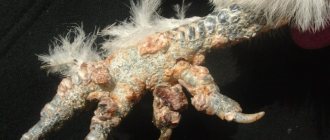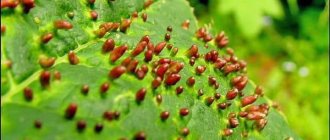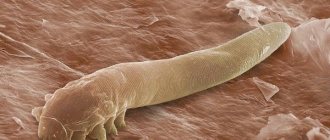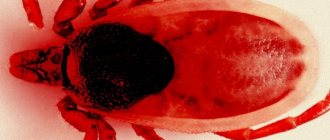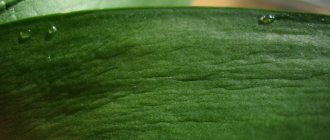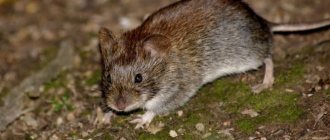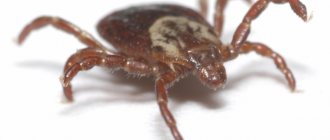Signs and consequences of infection
In the early stages of infection, while the spider mite has not yet entangled the plant in its web, it can be detected with a magnifying glass. You need to spread white paper under the lemon leaves and gently shake the tree. Fallen pests can be examined under a magnifying glass. You can suspect the appearance of a parasite on citrus fruits by the following signs: yellowing and drying of leaves, cobwebs on one side of the leaves, in which new parasites are hatched.
You can also soak a cotton swab in alcohol and wipe the leaves of the plant. If there is a pest, it will be visible on the cotton wool.
Fighting various types of ticks
There are several varieties of mites that damage plants. You should know that all of them are not insects, they belong to the order of spiders, so remedies against the former may not work. The common spider mite most often lives on indoor plants - this pest is omnivorous, affecting both citrus fruits and roses, dracaenas, fuchsias, and palm trees.
On citrus fruits there is also the Atlantic spider mite, which, in addition to lemons and tangerines, loves palm trees, and the red spider mite, which settles on callas, orchids and nightshades. The latter variety is very prolific, and the higher the air temperature, the more actively it lays eggs. In the cold it hardly reproduces. Can't stand cold showers. The Atlantic pest is characterized by increased resistance and is very tenacious even in high humidity, which other varieties do not like.
In addition to them, you can find the cactus flat mite or the red flat mite. These varieties are almost insensitive to treating the plant with a soap solution, although this reduces their population size. Parasites are destroyed using:
- insecticides;
- irradiating the plant with a UV lamp;
- pyrethrum infusion (2-3 g per 1 liter of water).
Biological method
The only enemy of the spider pest is the predatory mite Phytoseiulus persimilis. Its main and almost only food is spider mites. This predator is completely safe for humans, pets and plants. Using a mite against its kind is easy and pleasant; there is no need to waste time on tedious running around with spraying, soap, wrapping plants with film or washing clothes after treatment. In a day, the predator is able to find and eat 5 mites or 10 eggs, and it works ahead of the curve; spider mites reproduce more slowly. True, as soon as the entire population of spider mites dies, the predator also dies for lack of food.
Prevention and home remedies
All mites do not tolerate moist air well, so frequent spraying and periodic warm showers for plants are a good preventative measure. Timely removal of faded buds and old yellowed leaves may be useful. Mite eggs can retain live larvae for five years, so even with the apparent complete destruction of pests, there is always a risk that they will infect a plant or a collection of crops. Therefore, it makes sense to monitor the sterility of the soil when replanting a flower or washing its roots.
Another, albeit indirect, method of prevention is healthy plants with strong immunity.
Conditions suitable for lemon, sufficient lighting, timely replanting and pruning, periodic spraying with stimulants (Epin) will ensure that pests, even if they exist, will not be able to cause significant harm to the plant simply because the walls of the vessels are strong, elastic and quickly regenerated. Temporary or long-term violation of care conditions (withered leaves, heat, dryness, draft) - and mites quickly occupy the weakened plant.
It is not always possible to use strong drugs at home, for example, there may be children in the house or it is not possible to ventilate the room well. Please note: no “home” method can guarantee complete destruction, since the mites are very small. The following will help to partially cope with the pest on the lemon tree:
- Medical alcohol 96%. It will only get rid of adult pests; eggs cannot be destroyed, but with regular treatment it is possible to reduce the pest population. It evaporates quickly, so it does not damage the green mass, but it is not suitable for plants with thin leaves (lemon leaves are quite dense).
- Green soap. This is a special substance, environmentally friendly and completely safe for plants. Dilute soap in a proportion of 200 g (4 tbsp) per 10 liters of water. It is necessary to carefully spray the lemon tree with the resulting solution, paying special attention to the nodes, the underside of the leaves, and the axils. When processing, the pot should be covered with film, since soap, when it gets into the soil, disrupts its acidity.
- Laundry soap. Use a sponge to whip up foam and apply to leaves and branches. Leave for 3-4 hours, the soap will dry, forming a film. It is not very well tolerated by the plant itself, so the soap should be washed off, and the still wet flower should be wrapped in film and left overnight. The next morning you need to let the plant breathe and then repeat the procedure. This sequence is repeated at least three times. It is advisable that soapy water does not get on the ground, although spraying the surface layer cannot harm the roots. You should absolutely not spill soapy water on a clod of soil; most likely, the lemon will die.
- Dishwashing liquid. Effects on pests no worse than soap. It is advisable to take a product for treating children's accessories. The procedure is similar to that described above. In any case, if you wash the leaves of the plant, this will remove more than half of all mites. Be sure to disinfect the pot and the place where the plant stood.
- Garlic infusion and onion juice. Due to the characteristic odor, they are rarely used. The garlic infusion is prepared as follows: chop 2 heads of the vegetable, add 1 liter of water, leave for a week. The resulting infusion is diluted with water 2 times and the affected leaves are wiped.
Main lemon pests and signs of appearance
The appearance of insects on cultivated plants does not depend on careful care. In the warm season, parasites enter a person’s home from open windows, in the fall and winter - on bouquets, new flowers or from contaminated soil. Homemade lemons have many pests, the signs of which must be recognized.
Aphid
A small, sedentary bug feeds on the intercellular sap of plants and spreads viruses. Representatives of the species have a tiny body (up to 5 mm) and color from light yellow to deep black. Green aphids are more common in apartments.
Parasites on lemons gather in colonies on the underside of leaves, quickly multiply and spread throughout the plant. In places where they accumulate, the plates become deformed and bend. You can recognize an insect by:
- sticky coating on greens;
- crawling ants;
- unhealthy appearance of the tree.
Whitefly and its larvae
Small moths have opaque wings covered with a white coating. Adults are not dangerous to citrus plants. The voracious young hatch from eggs laid on the underside of the plates. The parasites feed on the cellular juice of the lemon and leave a sticky coating. Sweet drops become an excellent environment for the development of sooty fungus. The disease covers large areas and impairs photosynthesis.
Whitefly larvae can be recognized by their greenish bodies, shaped like small grains. On the affected plant, the foliage is covered with white spots from bites. If you do not fight the pest, the plates turn yellow, dry out and fall off. Insects are very dangerous during citrus blossoms.
Thrips
Small parasites are not noticeable in the first stages of invasion; they quickly multiply and spread throughout indoor lemons. Adults and larvae feed on the sap of the plant, leaving white marks and silvery streaks. The foliage brightens, falls off, the buds lose their shape and become covered with dark spots. The affected specimen weakens and stops developing.
Spider mites
Dangerous pests live and reproduce during heat and dry air. In conditions of high humidity, females hibernate. Insects burrow into the ground, hide in cracks in frames or under fallen greenery. Adults wake up after the restoration of a favorable microclimate.
The tiny parasite is invisible to the naked eye. You can recognize a tick by small holes in the leaves and thin cobwebs between the shoots. Affected lemons turn yellow and brown, curl and fall off. Photosynthesis processes are disrupted, growth and fruiting stop.
Scale insect and false scale insect
Dangerous pests of indoor plants produce up to 3 generations during the season. Insects on the foliage look like a seal located along the veins of the plates. Adults are immobile, but young animals migrate quickly, spreading the infestation. You can recognize the type of parasites by color and shape:
- false scale insects – oval dark brown;
- Scale insects are round gray.
Mealybug
Externally, the insect resembles a huge aphid, covered with a white, loose coating. Pests quickly spread throughout the lemon, weakening the plant and leaving sticky drops on the foliage. The affected citrus develops poorly and withers. When neglected, dark spots of sooty fungus appear.
Nematodes
Small worms feed on lemon roots, so they are difficult to notice with the naked eye. Males have an elongated body, females have a spherical body. Under unfavorable conditions, the eggs sleep in the ground for a long time. The affected parts are covered with swellings that turn into necrosis. The foliage loses turgor and turns yellow. Indoor trees stop growing and die.
Springtails or springtails
Tiny jumping insects appear in the soil with high humidity, poor drainage and the use of organic fertilizers. Light-colored arthropods feed on rotting plant debris and move quickly. Springtails are not dangerous to home flowers, but in large numbers they can damage the roots. The abundance of scurrying worms indicates mistakes in caring for citrus.
Sciarids (midges)
Soil mosquitoes have a narrow winged body and a round head. Adults do not feed, and young animals eat rotting plant debris. Externally, young sciarids resemble ringworms, with a translucent body and a noticeable digestive system.
During mass reproduction, there is not enough food, so the larvae eat the roots and green parts of the plant in contact with the ground. Insects prefer a moist environment and an abundance of organic matter. They leave behind a sticky, slimy trail on the soil surface. If you take the worms out of the ground, they die within 5 minutes.
Mycoses and infections
They can be carried by parasites, and can also occur due to improper care of home citrus fruits.
Gum discharge of citrus fruits
It can also be called gommosis. Refers to mycoses. All citrus fruits are prone to it, and a common pathogen is Phytophthora citrophthora.
The fungus develops best in a room that is too humid, when the bark is damaged, or when there is a lack of potassium or phosphorus. Also, gum deposition can be caused by a large amount of nitrogen in the ground, diseased soil and a trunk that is too deep.
They can be identified by their oblong red-brown spots. The bark under the stain cracks and dies; a sticky, golden-colored liquid appears on the cracks, which hardens quickly.
For treatment, you need to cut off all the spots on the bark. Next, treat all wounds with copper sulfate (concentration 3%). We cover the top with garden varnish. We repeat this procedure until the stains disappear from the lemon bark. Branches with gommosis must be removed entirely.
Reproduction of ticks
Several generations live in the web they create. Ticks multiply at tremendous speed. Fertile females lay many round eggs. At first they are almost transparent, but after a while they become yellowish cloudy. The rate of embryo development depends on temperature. At +15 degrees - 15 days, at +30 - only two to three days! The full cycle occurs: from 30 to 36 days, if conditions are unfavorable, from 7 to 8, if conditions are good.
It becomes clear that the fight against spider mites on indoor plants should begin as early as possible. At low temperatures and high humidity, the larvae slow down their development. As conditions improve, mass infection occurs. Considering that spider mites quickly move to healthy plants, you need to know how to get rid of the mite in order to prevent the mass death of green pets. What harm do spider mites cause? When damaged, the plant becomes weak.
Signs of plant damage:
- the underside of the leaves is strewn with small dots;
- the entire plant or individual parts are intertwined with cobwebs;
- in case of severe damage, swarming pests can be seen in the web.
Spider mites carry:
- viral infections;
- gray rot spores.
Types of predators
There are two types of predators:
- Phytoseiulus. It reproduces very quickly; the more active hunters are females, who are able to dine on more than 20 adult spider mites per day, while simultaneously laying 2-6 eggs. The females are quite mobile; having eaten all the pests in the accessible area, they move further. The eggs hatch into larvae, which are also considered the only food for the spider mite colony. Phytoseiulus loves high air humidity and average temperatures. The number of predators is calculated by eye, depending on how heavily infested the tree is and what size it is. For mild damage, 10 or 20 ticks will be enough, for medium damage, 30 to 50 individuals will be required.
- Amblyseius. It feeds not only on ticks, but also on thrips. It is very popular among greenhouse owners abroad. The only drawback of Amblyseius is that it is weakly capable of searching, that is, it feeds where it is planted. Therefore, it should be placed in close proximity to the colony. In addition, the density of predators and prey should be observed. Amblyseius is usually used for prevention.
The arsenal of methods to combat ticks is wide; it is most effective to use their combinations. If the collection of citrus fruits is large, it is worth considering biological methods as the safest, most effective and least troublesome.
Causes of diseases and their treatment at home
Sometimes citrus fruits become infected with fungal and viral infections. At home this happens for the following reasons:
- pests:
- fluid stagnation;
- high or low humidity;
- cold air;
- contaminated soil and planting material;
- non-compliance with watering rules;
- proximity to infected plants;
- lack of nutrients.
Gommoz
Hommosis is a fungal disease. It is also called gum bleeding. Symptoms of the disease look like this:
- longitudinal brown spots appear on the trunk and branches;
- the bark in the affected areas dies and cracks;
- a golden liquid called gum begins to flow from the cracks.
The development of fungus is provoked by a number of factors:
- deepening the root collar during planting;
- moisture stagnation;
- excess nitrogenous fertilizers.
To save the plant, the affected areas are cut out and covered with a thick layer of garden varnish. The tree is sprayed with a solution of copper sulfate.
Mosaic
Mosaic is a viral disease. Spread by insects and wind. The leaves of affected plants are covered with light spots, which are located mainly along the plate.
The disease cannot be cured. The affected tree will have to be destroyed.
This is interesting:
How to save tangerines from worms and diseases.
Gooseberry diseases and their treatment.
Anthracnose
Anthracnose is another disease caused by flexi. It is activated by increased soil or air humidity and low temperature. The development of infection is promoted by deficiency of phosphorus and calcium.
Round brown spots with clearly defined, slightly convex edges form on the leaves of a diseased plant. Then the spots spread to the leaves and fruits.
Before treating the disease, the diseased parts of the plant are cut off. The tree is sprayed with a fungicide, for example, Topaz.
Attention! Fungicides are poisonous to humans. It is important that they do not get on dishes and food. The fruits of plants that have been processed during and after flowering are not eaten.
Chlorosis
This disease occurs as a result of stagnation of moisture, acidification of the soil, deficiency of iron and other elements. In this case, there is a decrease in the activity of photosynthesis and the formation of chlorophyll. The first sign is yellowing of the leaves and then their falling off. Then the tops of the shoots may dry out, the roots die, and the leaves become shredded.
With chlorosis, the soft tissues of the leaves turn yellow, but the veins remain green.
It is clear that the disease is caused by a violation of care, so first of all you need to eliminate them:
- Get rid of stagnant moisture, dry the soil, and replace it if necessary. Rinse and dry the drainage. You may need to transplant it into another, smaller pot.
- Test the acidity of the soil using litmus paper. If it is high, then the soil should be deoxidized by adding fluff lime or chalk. To do this, take half a tablespoon of powder and dilute it in a glass of warm water, then water the soil in the pot. The acidity of the water flowing from the drainage holes is measured, and if it is still high, the procedure is repeated until the pH level is within 6-6.5 units.
- Replenish iron deficiency by adding preparations containing it in chelated form, such as Ferrofit, Ferrilen, Antichlorosis, Micro-Fe and the like. Or you can simply dissolve 20-40 grams of iron sulfate in one liter of water and feed the plant.
Phyllosticosis
This fungal disease is also called brown spot. A sign of the disease is the formation of brown or dark brown spots of round, oval or irregular shape on the leaves. If treatment is not started, the spots grow and cover the entire surface of the leaf blade, after which the leaves dry out and fall off. Favorable conditions for the development of fungus are dampness and air temperature of +25 °C and above. The source of infection is soil, water, purchased flowers, etc.
When affected by phyllosticosis, brown spots form on the leaves of plants
To cure a plant, you should tear off the affected leaves and treat the crown with fungicides (these are drugs to combat fungal diseases). Popular drugs are Horus, Quadris, Abica-Peak and others. It is better to use them outdoors, but if you still have to use them indoors, then take precautions - prevent the drugs from getting on food or dishes, and ventilate the room after treatment. If the infection is not severe, then it is better to use biological products such as Fitosporin-M, which is absolutely safe for humans, animals and bees. At the same time, it is also a fertilizer, as it contains humic acids.
Scab
Scab is caused by a fungal infection. It leads to the falling of leaves, shoots and lemon fruits.
As the disease develops, small pinkish or brown warts appear on the underside of the leaf blade. At their top there is a depressed area in which the bend is located. From the leaves, the infection spreads to fruits and shoots. All affected parts fall off.
To save the lemon tree, all infected parts are cut off. Places where shoots are cut are lubricated with garden varnish. The plant is sprayed with a solution of 1 tsp. copper sulfate and 3 liters of water.
Sooty fungus
Sooty fungus in late stages of development covers all parts of the plant. This leads to disruption of photosynthesis, arrest of development and death of the lemon.
The causes of the disease are as follows:
- waste products of pests on leaves and shoots;
- increased humidity in the room;
- temperature violation.
When infected, small areas of black plaque appear on the leaves. Gradually they increase in size and cover the entire plate. The infection spreads to fruits and shoots.
To cure the disease, wipe the affected areas with a damp cloth. After this, they are treated with a biological preparation, for example, Fitosporin. They spray the above-ground part of the plant and water the soil in the pot.
Why indoor lemon turns yellow and flies away Watch this video on YouTube
Root rot
Root rot is a fungal infection that attacks the roots. It is difficult to notice at the beginning of infection. The first signs appear when the above-ground part of the plant withers.
Root rot occurs due to deep planting, improper replanting, watering with cold water and waterlogging of the soil.
To treat it, a number of measures are taken:
- The plant is dug up and washed from the ground. The roots are inspected for damage, and damaged areas are cut off.
- The roots are soaked for half an hour in a solution of potassium permanganate, then the cut areas are covered with garden varnish. The lemon is soaked in a root formation stimulator for several hours.
- The plant is transplanted into disinfected soil.
Cancer
Citrus canker is a viral disease. It is spread by pests and wind. Plants with weakened immune systems are most vulnerable to it.
Symptoms of citrus cancer:
- small red round spots with a yellow border appear on the leaves;
- soon the formations turn into shoots and fruits;
- spots blur and increase in size;
- the plant dries out.
The disease cannot be treated. The infected lemon dies. To prevent it from infecting other plants, it is eliminated at the initial stage of disease development.
Description of indoor lemon diseases
Indoor lemons can get sick in several cases:
- With insufficient care - improper pruning, contaminated soil, insufficient fertilization, lack of light.
- If the plant has weak immunity after previously suffering from illnesses.
- If a diseased cutting was grafted.
- If parasites brought pathogenic bacteria to the lemon.
- Viral diseases of indoor lemons
Typically, citrus fruits shed their leaves. Sometimes leaves are shed due to a lack of some trace element. But more often than not, it is the disease that is to blame. It is because of them that indoor lemon can die.
Mosaic virus
Leaf mosaics can be identified by the strokes on the leaves of a citrus fruit: they can be thickly colored or lighter, but they always have the shape of a mosaic. The growth of indoor lemons slows down when sick.
Unfortunately, there is no treatment, but the symptoms can be reduced. To do this, you need to care for lemons correctly and fertilize them abundantly. If you have several indoor lemons, alas, it is better to destroy the diseased one.
Prevention is to prevent aphids from approaching the plant. It is also better not to water lemons with cold water so that their immunity does not weaken.
Citrus cancer
They can be identified by brownish spots on the peel and leaves. As the disease develops, the fruits become unsightly and the lemon leaves fall off. The plant dies.
It is impossible to treat citrus cancer. For preventive purposes, lemon can be treated with a fungicide based on liquid copper.
The virus “loves” lemons that do not receive good care and are weakened. It can be identified by the loss of leaves, as well as the death of branches and bark. It is impossible to treat tristeza; it certainly leads to the death of citrus fruits.
Spider mites on lemon: how to fight at home
There are chemical and natural ways to combat this parasite.
Chemicals
It is important to understand that after treatment with chemicals, the fruits can be removed and eaten only after 2 months. In severe cases, the harvest will have to be sacrificed. Sometimes it is not possible to use strong drugs in the house, since there may be children there, or the room cannot be well ventilated.
To achieve complete destruction of the parasite, you need to be patient. Several treatments will be required with an interval of 7-10 days, since the eggs laid by ticks are resistant to chemical control agents, and new individuals emerge from them soon after treatment.
The following drugs have proven themselves well.
Fitoverm
This is a relatively safe drug. To completely get rid of spider mites, you will need to spray the crown of the lemon tree 4 times with an interval of 6-9 days. A new solution must be prepared each time, according to the instructions. After its use, after 10-16 hours, the parasites lose the ability to eat food, and after 2-3 days they die. The drug has an unpleasant feature - a specific smell.
Damiant
The acaricide is effective against spider mites at all stages of development, including summer eggs. When infestation levels are high, the chemical ensures rapid population decline. The poison does not develop resistance in lemon pests, so there is no need to alternate with analogues. The product has a long protective period (30-40 days).
Aktellik
When treated with this product, not only spider mites die, but also aphids, scale insects and other pests. Spraying can only be carried out in a room where there are no children and animals, and an open ampoule cannot be stored. According to the instructions, you need to mix 1 ml of the substance with 1 liter of water. Parasites die by contacting Actellik and inhaling its vapors. The treatment will have to be repeated at least 3 times every 7 days.
Demitan
This is the most effective means of combating spider mites on lemon. Valid from 45 to 60 days. Pests die upon contact with the substance that was used to treat the plant. But this drug should not be used repeatedly, as arthropods get used to it.
Folk remedies
Folk remedies are safe, and the fruits can be removed even the next day. The following folk methods of combating spider mites can be distinguished:
- wipe the plant with a cotton pad soaked in alcohol;
- lather a sponge with laundry soap and wipe the citrus tree (after covering the pot with a bag), rinse with a warm shower;
- spray in the morning and evening with acaricide diluted in water. To provide a moist environment that ticks cannot tolerate, you can put a plastic bag over the crown. Treatment should be repeated 3-5 times every 5-6 days;
- dilute green soap with water in a ratio of 200 g per 10 liters. Cover the pot with a bag and spray the lemon tree;
- wash the leaves with dishwashing detergent, which acts on pests no worse than laundry soap;
- rubbing the leaves with garlic tincture and onion juice is also quite effective, but this method is used less frequently due to the specific smell. To prepare the infusion, you need to pour 2 heads of garlic with a liter of water and leave for a week.
Various drugs
There are general rules for all drugs:
- It is advisable to carry out the treatment in the fresh air, if this is not possible, in a very well-ventilated area.
- Use gloves. If necessary, use a mask. The recommendation for personal protective equipment is on the packaging of all drugs, but not all gardeners follow them.
- Clothes after treatment should be washed; surfaces on which the product may have come into contact should be washed thoroughly.
- Under no circumstances should it be disposed of in the apartment.
- Most products are contact, that is, pests die when they come into contact with the drug. Conclusion: you need to carefully treat the surfaces.
About the tools themselves:
- Actellik is a very powerful “killer” agent that will reliably get rid of ticks on a lemon. Acts on arachnids. It is recommended if plants are heavily and extensively affected by mites. The drug is extremely toxic, with a pungent odor.
- Neoron is a universal substance that can destroy both adults and eggs. One procedure, of course, is not enough, but two, as a rule, are enough to completely get rid of pests.
- Fitoverm is a fairly well-known drug because it is less toxic than others. It is perfectly acceptable (though not advisable) to spray it on plants in the bathroom. Affected lemons are treated with Fitoverm 3-4 times, at intervals of a week.
- Sunmite is similar in action to Neoron. The Japanese drug in powder form is very effective against ticks at any stage of development, but it is used on one plant no more than once a year, otherwise the ticks get used to it. Disadvantage: rarely found on sale.
- Aktofit is used mainly by greenhouses for treating open ground plants, but can also be used for indoor plants. The tick will require 1-2 treatments, at the rate of 4 ml of the drug per 1 liter of liquid.
- Aktara - the drug is not claimed to act against spider mites, it is an insecticide, it works against insects. However, in practice, many note that Aktara is really effective: after spilling a clod of earth with an affected tree, the mites disappear.
- Nissoran is a drug in powder form. Effective on all stages of ticks, except adult ones. That is, it will get rid of eggs, larvae, and nymphs of spider mites. It has a long-lasting effect (up to 1.5 months) and is non-phytotoxic. It is effective to use before there are too many adults. The result will be noticeable after 10 days (this is the period during which adult pests die of natural causes).
- Akarin is a drug in ampoules, characterized by a high speed of action, it affects ticks after 8-16 hours (on gnawing pests - after 4 hours).
- Apollo is a liquid drug that is rarely found on sale. However, it is popular among advanced gardeners in the fight against mites, because it is designed to protect the plant specifically from them and is able to act on eggs and larvae. The drug does not affect adult individuals, however, depriving them of the opportunity to reproduce (remember that the lifespan of a spider mite is from 30 hours to 8 days), quickly leads to the complete death of the parasites. The drug does not act once, but over a prolonged period; as a rule, 1-2 treatments are sufficient.
- Vermitek - dissolve 2.5-3 ml in 10 liters of water. Spray the plant, then wrap it in polyethylene and remove it after a day. The drug penetrates the flower tissue, thereby ensuring activity even after treatment.
- Agravertine - used against spider mites and many pests of open ground, for example, the Colorado potato beetle. Unlike most of the listed drugs, which act on the digestion of pests, it attacks their nervous system, causing paralysis. The parasites stop moving 6 hours after treatment and die within 2-3 days. To treat indoor lemons, dilute 5 ml per 1 liter of water.
Folk ways to combat spider mites
Due to their high toxicity, the chemicals are dangerous to use at home. Traditional recipes show good results in the initial stage and with a low level of infection. To get rid of spider mites on indoor lemons, you need regular procedures.
Plants are neighbors
Geranium is a popular flower that is often grown at home. To prevent pests from appearing on the lemon, you need to place a pot next to it with a fragrant neighbor. The plant emits a specific aroma that repels spider mites. Insects do not like the smell of garlic.
Rosemary essential oil
The fragrance of the oil concentrate is unpleasant for the dangerous pest. Add 10 drops of the drug to a liter of warm water and pour into a spray bottle. Every day, the lemon crown is generously sprayed with liquid until the signs disappear. During hot periods, place a bowl with an aromatic solution next to the plant.
Ultraviolet
Radiation is detrimental to spider mites and beneficial for indoor culture. If you irradiate the tree with a UV lamp for a few minutes a day, you can easily get rid of the parasite. Regular short-term procedures will strengthen the plant’s immunity and stimulate the formation of fruits.
Smoking a lemon
Nicotine is a poison for all types of parasites. Smoke from burning tobacco creates unfavorable conditions for uninvited guests. If you carry out the event within 3-4 weeks, it is easy to get rid of the infestation on citrus.
Use of insect predators
A biological control method will help cope with spider mites on lemon. The insect, which is harmless to people and pets, feeds on a dangerous pest. Garden stores offer predators:
The printed package is fixed on the affected plant. Insects move into the pot. During the day, 1 individual eats 10 eggs or 5 adult pests. If the food runs out, the predators will die.
Biological method
The only enemy of the spider pest is the predatory mite Phytoseiulus persimilis. Its main and almost only food is spider mites. This predator is completely safe for humans, pets and plants. Using a mite against its kind is easy and pleasant; there is no need to waste time on tedious running around with spraying, soap, wrapping plants with film or washing clothes after treatment. In a day, the predator is able to find and eat 5 mites or 10 eggs, and it works ahead of the curve; spider mites reproduce more slowly. True, as soon as the entire population of spider mites dies, the predator also dies for lack of food.
How to get rid of aphids on lemon
To prevent the infection from developing into a severe infestation, measures should be taken in time. Controlling aphids on plants in the early stages will prevent severe destruction of citrus. If you manage to detect a parasite, you need to use effective means.
Traditional methods
Garlic infusion has a strong aroma that insects do not like. The head is crushed in a blender or through a meat grinder. The resulting mass is poured with a glass of hot water and left in a dark place for 48 hours. The solution is filtered and poured into a spray bottle. The plants need to be treated every other day for a week, then after 7 days the event is repeated.
An aqueous infusion of tobacco dust is a strong insectoacaricide that fights all sucking parasites. Laundry soap will help improve adhesion to foliage. Lemon should be sprinkled generously. To protect the soil from alkalization, you need to cover the pot with film. The procedures are repeated every other day for 5 days, then a week break.
Crushed wood ash is an effective folk remedy for aphids. Fine powder is sprinkled on the foliage of the plant. If you add raw materials to soapy water, you can easily remove parasites. Spray the lemon or rinse the affected plates.
An infusion of dry mustard quickly copes with a medium infestation. The working solution is prepared from 70 g of spice and 1 liter of boiling water. The liquid is stirred until smooth and tightly closed for 3 days. The spray concentrate is diluted with water in proportions of 1 to 3.
The ladybug is a natural enemy of aphids, with which it is easy to reduce the number of aphids. Several tiny predators do not harm the cultivated plants at home; they quickly devour the colony. After eradication, the insects are released into the wild.
Insecticides
Chemicals affect the nervous system. Affected specimens stop sucking juice from the leaves and die from starvation or organ dysfunction. Iskra Zolotaya fights against aphids, mites and thrips. Add 1 ml of poison to 5 liters of water and spray the greens. For 25 days, the insecticide protects lemons and new shoots.
Aktara is a systemic drug that penetrates the foliage through the roots. After watering, the chemical is distributed throughout the plant tissues and reaches the top on the 3rd day. The product is not afraid of bright sun and high temperatures, protects lemons of any size for a month, and when sprayed – for more than 50 days.
The commander fights not only with adults, but also with eggs and larvae. A strong insecticide after one treatment protects the tree from parasites for a period of 2 to 4 weeks. The procedures are carried out outdoors wearing protective gloves and a mask.

